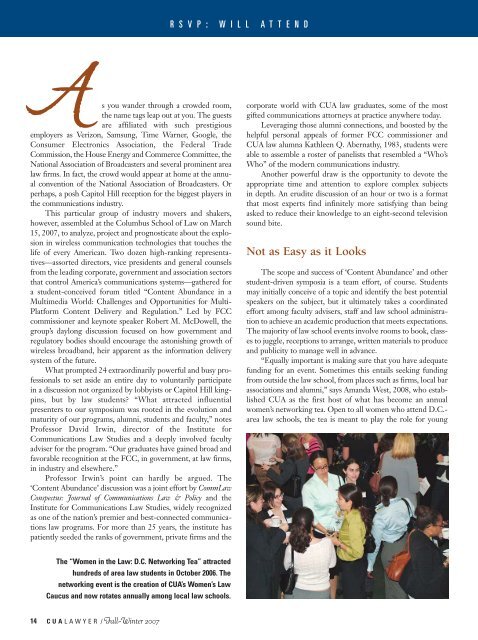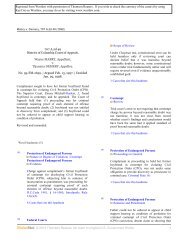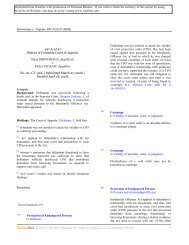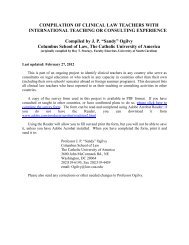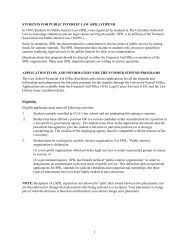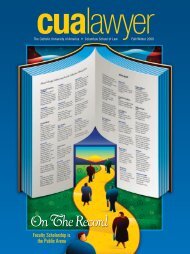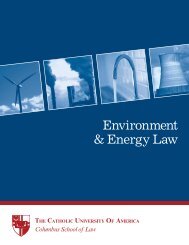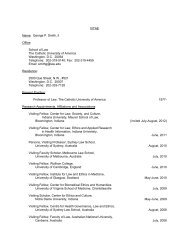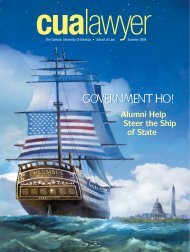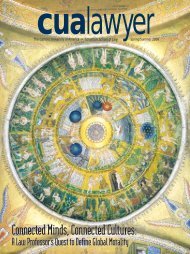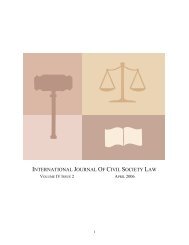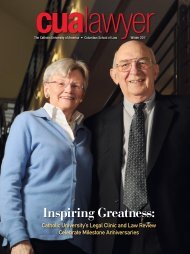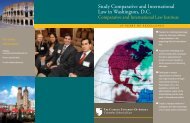CUA Cover Winter 2005 final (Page 2) - Columbus School of Law
CUA Cover Winter 2005 final (Page 2) - Columbus School of Law
CUA Cover Winter 2005 final (Page 2) - Columbus School of Law
- No tags were found...
Create successful ePaper yourself
Turn your PDF publications into a flip-book with our unique Google optimized e-Paper software.
R S V P : W I L L A T T E N DAs you wander through a crowded room,the name tags leap out at you. The guestsare affiliated with such prestigiousemployers as Verizon, Samsung, Time Warner, Google, theConsumer Electronics Association, the Federal TradeCommission, the House Energy and Commerce Committee, theNational Association <strong>of</strong> Broadcasters and several prominent arealaw firms. In fact, the crowd would appear at home at the annualconvention <strong>of</strong> the National Association <strong>of</strong> Broadcasters. Orperhaps, a posh Capitol Hill reception for the biggest players inthe communications industry.This particular group <strong>of</strong> industry movers and shakers,however, assembled at the <strong>Columbus</strong> <strong>School</strong> <strong>of</strong> <strong>Law</strong> on March15, 2007, to analyze, project and prognosticate about the explosionin wireless communication technologies that touches thelife <strong>of</strong> every American. Two dozen high-ranking representatives—assorteddirectors, vice presidents and general counselsfrom the leading corporate, government and association sectorsthat control America’s communications systems—gathered fora student-conceived forum titled “Content Abundance in aMultimedia World: Challenges and Opportunities for Multi-Platform Content Delivery and Regulation.” Led by FCCcommissioner and keynote speaker Robert M. McDowell, thegroup’s daylong discussion focused on how government andregulatory bodies should encourage the astonishing growth <strong>of</strong>wireless broadband, heir apparent as the information deliverysystem <strong>of</strong> the future.What prompted 24 extraordinarily powerful and busy pr<strong>of</strong>essionalsto set aside an entire day to voluntarily participatein a discussion not organized by lobbyists or Capitol Hill kingpins,but by law students? “What attracted influentialpresenters to our symposium was rooted in the evolution andmaturity <strong>of</strong> our programs, alumni, students and faculty,” notesPr<strong>of</strong>essor David Irwin, director <strong>of</strong> the Institute forCommunications <strong>Law</strong> Studies and a deeply involved facultyadviser for the program. “Our graduates have gained broad andfavorable recognition at the FCC, in government, at law firms,in industry and elsewhere.”Pr<strong>of</strong>essor Irwin’s point can hardly be argued. The‘Content Abundance’ discussion was a joint effort by Comm<strong>Law</strong>Conspectus: Journal <strong>of</strong> Communications <strong>Law</strong> & Policy and theInstitute for Communications <strong>Law</strong> Studies, widely recognizedas one <strong>of</strong> the nation’s premier and best-connected communicationslaw programs. For more than 25 years, the institute haspatiently seeded the ranks <strong>of</strong> government, private firms and thecorporate world with <strong>CUA</strong> law graduates, some <strong>of</strong> the mostgifted communications attorneys at practice anywhere today.Leveraging those alumni connections, and boosted by thehelpful personal appeals <strong>of</strong> former FCC commissioner and<strong>CUA</strong> law alumna Kathleen Q. Abernathy, 1983, students wereable to assemble a roster <strong>of</strong> panelists that resembled a “Who’sWho” <strong>of</strong> the modern communications industry.Another powerful draw is the opportunity to devote theappropriate time and attention to explore complex subjectsin depth. An erudite discussion <strong>of</strong> an hour or two is a formatthat most experts find infinitely more satisfying than beingasked to reduce their knowledge to an eight-second televisionsound bite.Not as Easy as it LooksThe scope and success <strong>of</strong> ‘Content Abundance’ and otherstudent-driven symposia is a team effort, <strong>of</strong> course. Studentsmay initially conceive <strong>of</strong> a topic and identify the best potentialspeakers on the subject, but it ultimately takes a coordinatedeffort among faculty advisers, staff and law school administrationto achieve an academic production that meets expectations.The majority <strong>of</strong> law school events involve rooms to book, classesto juggle, receptions to arrange, written materials to produceand publicity to manage well in advance.“Equally important is making sure that you have adequatefunding for an event. Sometimes this entails seeking fundingfrom outside the law school, from places such as firms, local barassociations and alumni,” says Amanda West, 2008, who established<strong>CUA</strong> as the first host <strong>of</strong> what has become an annualwomen’s networking tea. Open to all women who attend D.C.-area law schools, the tea is meant to play the role for youngThe “Women in the <strong>Law</strong>: D.C. Networking Tea” attractedhundreds <strong>of</strong> area law students in October 2006. Thenetworking event is the creation <strong>of</strong> <strong>CUA</strong>’s Women’s <strong>Law</strong>Caucus and now rotates annually among local law schools.14<strong>CUA</strong>LAWYER /Fall–<strong>Winter</strong> 2007


